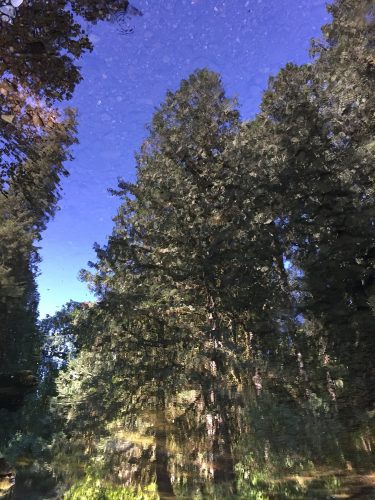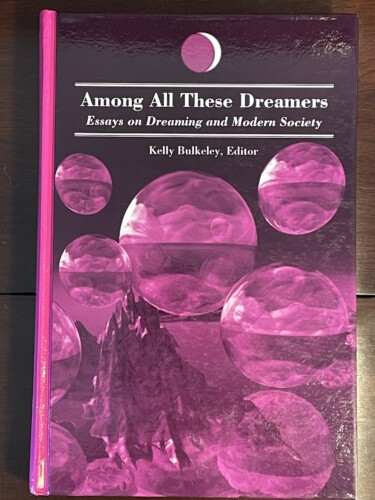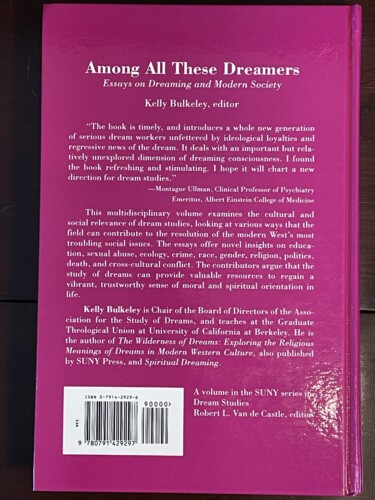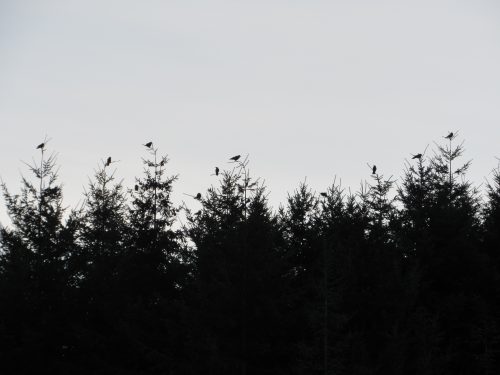 A study from 2015 about the distinctive patterns in the dreams of “Jasmine,” a young sight-impaired musician. First presented at the annual conference of the International Association for the Study of Dreams, in Virginia Beach, Virginia.
A study from 2015 about the distinctive patterns in the dreams of “Jasmine,” a young sight-impaired musician. First presented at the annual conference of the International Association for the Study of Dreams, in Virginia Beach, Virginia.
Introduction
This presentation demonstrates the use of a digital word search method to study 800 dreams recorded in a personal journal over a period of several years by a female participant. A “blind” analysis, focusing exclusively on the frequencies of word usage in her dreams, enabled several accurate predictions about her waking life, including the fact that she has been sight-impaired since early childhood.
Methods
The word search method I will describe has relevance for researchers from any background who are interested in the systematic study of dream content. The great advantage of quantitative approaches to the study of dreams, like the Hall and Van de Castle system, is that they provide objective statistical results that other researchers can compare, replicate, and extend. However, there are serious disadvantages to traditional hand-coding methods—they are time-consuming, labor-intensive, hard to learn, and vulnerable to problems with inter-coder reliability. Particularly when the coding systems being employed are untested or idiosyncratic, the results can be disappointing. Digital word search methods provide a viable alternative: they are fast, easy to use and share, and reliably consistent in their results. Of course, such methods do not supplant other approaches to dream research. Digital tools are best used as complementary resources in the study of dreams, providing an empirically grounded assessment of basic patterns of dream content.
Over the past several years, and usually in collaboration with G. William Domhoff and Adam Schneider, I have pursued several studies using word search methods to analyze particular sets or series of dreams:
The Religious Content of Dreams: A New Scientific Foundation. Pastoral Psychology 58(2): 93-101.
[Merri, Barb Sanders]
Seeking Patterns in Dream Content: A Systematic Approach to Word Searches. Consciousness and Cognition 18: 905-916.
[Paul, HVDC Male and Female Norms]
Detecting Meaning in Dream Reports: An Extension of a Word Search Approach. (co-authored with G. William Domhoff). Dreaming 20(2): 77-95.
[Van]
Dreaming in Adolescence: A “Blind” Word Search of a Teenage Girl’s Dream Series. Dreaming 22(4): 240-252.
[Bea]
Digital Dream Analysis: A Revised Method. Consciousness and Cognition 29: 159-170.
[The Engine Man, Barb Sanders, HVDC Male and Female Norms]
All of these studies, and several others not yet published, have led to new insights about using word search methods to identify meaningful patterns in dream content. I have focused special attention on projects using a “blind analysis” framework in which I start with as little information as possible about the dreamers, focusing exclusively on the statistical frequencies of word usage in their dreams. I make a point of knowing nothing about the dreamers’ personal lives, and I do not read the narratives of their dreams. This approach imposes an artificial set of constraints that concentrates all my analytic attention on the word usage frequencies. By bracketing out every other source of information, I try to glean as many insights as possible from the word usage patterns alone. The present study is the latest in this series of word search investigations.
Participant
“Jasmine” (not her real name) contacted Domhoff in 2014 and offered to share her lengthy dream journal with him for research purposes. He then contacted me, and with her permission we arranged a blind analysis process whereby I uploaded four sets of Jasmine’s dream reports into the Sleep and Dream Database (SDDb) in order to perform the subsequent word searches. I knew nothing about Jasmine besides her being female, and my only other bit of knowledge was that the four different sets of her dreams followed a chronological order.
Procedure
Once the dream reports were uploaded, I used the SDDb’s 2.0 word search template to calculate the word usage frequencies for each of 40 categories (many of which overlap with Hall and Van de Castle categories), for each of the four sets of dreams. I then compared the results with the SDDb Baselines, a large collection of “most recent” dreams from various sources that provides a measuring stick for looking at how a given set of dreams relates to what current evidence suggests are the normal patterns of ordinary dream content. I also compared the four sets of dreams with each other, looking for patterns of consistency and variation from one set to the next.
Based on these word search findings, I formulated 21 inferences about Jasmine’s waking life. These inferences derived from the continuity hypothesis that patterns of dream content accurately reflect a person’s concerns, relationships, and activities in the waking world. I used as a working assumption the idea, supported by previous studies, that frequencies of word usage in dreams are continuous to some degree with the individual’s waking life concerns. My inferences about Jasmine’s waking life were predicated on that assumption.
I sent the inferences to Domhoff, who forwarded them to Jasmine. Once I received her responses, I was no longer “blind,” in the sense that now I knew a great deal about her personal life and could see where her waking life concerns had crossed over into her dreaming. We engaged in several more email exchanges to answer her questions and learn more about various details of her personal upbringing and family background.
Results
Appendix 1 presents the results of the word search analysis using the SDDb 2.0 template. Below are the 21 inferences I formulated based on the word search results, and Jasmine’s initial responses to them (in bold italics):
1. Jasmine is blind or sight-impaired. yes
2. Hearing is an especially important sense for her. yes
3. Jasmine has very close relations with her family.
Well, it’s complicated. I would say that I’m close to some of them, particularly on my mom’s side. My siblings live far away, and so sometimes I miss them and remember things we used to do together. I have complicated relationships with those on my dad’s side in general.
4. Her most important relationship is with her mother. Yes!
5. She is very involved with birds, especially chickens.
Yes, I had pet chickens almost my whole life growing up, and other feathered pets as well. J
6. She enjoys books, reading, and writing. Yes
7. She is very active musically, especially singing and playing
piano. Yes!
8. She is, or recently has been, a student in college. yes
9. She was raised as a Christian and she now regularly attends church.
Well, this is complicated too. My family wasn’t really that religious, but sometimes we would go to church when I was little.
Domhoff also asked that, in addition to making general inferences, I make some specific inferences based on comparing the first two sets to the third set, and the third set to the fourth set.
Looking at the time period covered by the third set compared to the earlier two sets of dreams, Jasmine was:
10. More fearful and anxious. Not sure, I can’t really remember.
11. But also happier than before.
This is possible. I started to gain more independence in this period, so I think 10 and 11 might both be true, to a degree.
12. Less involved with her family. Yes, this jives with the above. J
13. Drinking more coffee. I don’t remember starting then, but I like coffee now.
14. More involved with piano music. yes
15. More involved with religion and church. Yes, because I started playing the organ.
Looking at the time period covered by the fourth set of dreams compared to the time period covered by the third set, Jasmine was:
16. Less fearful and anxious. Not sure
17. More involved with her family. No, not really.
18. More involved with birds.
No, I didn’t have any pets, and my last chicken and my cockatiel died before this time. This didn’t really happen, but I can remember dreaming a lot of dreams centering around forgetting to feed, or otherwise take care of them.
19. More actively engaged with the public world (indicated by more references to movement, travel, work, clothing). Yes, we could say that I gained even more independence at this time. This is when I got my first real job!
20. Still very musically active with piano and singing. yes
21. Even more involved with a Christian church. Yes, playing the organ and attending regularly, but not always seeing things like they do.
Discussion
Of the 21 dream-based inferences about her waking life, Jasmine confirmed 15 of them as accurate (and 9 of 9 for the general inferences at the beginning). She said she was not sure about four of the inferences, although she allowed that two of those “might both be true, to a degree.” That would raise the total number of correct inferences to 17 out of 21. Either way, this is an accuracy ratio comparable to previous studies of the Van series (12 of 14 inferences correct) and the Bea series (11 of 15 inferences correct).
On the issue of her blindness, I based my inference on the fact that her frequency of vision-related words was lower than her frequency of hearing-related words. That is a very rare pattern that I have only found in one other group—the blind people whose dreams Hurovitz and his colleagues wrote about in their 1999 study. I’m not sure this will hold up as a universally valid principle, but in Jasmine’s case the relatively low frequency of vision-related words combined with the high frequencies of other sensory terms made it led me to infer that she was blind or sight-impaired in waking life.
In their 1999 study Hurovitz et al. found some evidence of continuity between blind people’s difficulties moving around in waking life and their dreams of movement and transportation. I did not think of that when formulating my inferences, but now that I look at the findings with Jasmine I do see elevated levels of references to walking & running, falling, and transportation, compared to the frequencies in the SDDb baselines.
The accurate inferences about her family and her mother underscore the strong continuities between waking and dreaming in terms of social relationships. This is one of the areas where dream content most directly mirrors the feelings and concerns of a person’s waking life. Further evidence of the same point comes with the correct inference about chickens. Such a high frequency of words relating to chickens and other birds is quite rare, and in this case it accurately reflects the emotional importance of her relationships with these creatures over the course of her life.
Jasmine’s extremely high frequency of references to art-related words involving music, combined with her high frequency of hearing words, suggested that music plays a big role in her waking life, as indeed it does. It turns out that Jasmine is quite gifted musically; she sings, plays piano, and in recent years has been playing the organ at churches. Her religious activities have in fact increased in recent years, as I inferred, but she expressed some discomfort with the doctrinal teachings at these churches.
The inferences about changes in her life from one period of time to another were less successful than the inferences about her waking life in general. Jasmine disagreed with two of my inferences predicting that between the third and fourth sets she became “more involved with” her family and with birds. One possible explanation for the mistaken inference is that I used the word “involved” ambiguously in the question. Jasmine seemed to take it as asking whether or not she had more direct physical interactions with her family and birds. To that question she answered no, she was not more involved with them in that literal sense, in large part because she had just started a new job and was away from her usual home setting more than ever before. However, if I had phrased the inference to include not only “physical interactions with” but also “thoughts or emotional concerns about,” she may have responded differently. At this key transitional time in her personal development, the rise in dream references may have reflected a greater emotional concern about her relations with family and birds, even though she was not actually interacting with them as much as in the past. As Jasmine herself said in her response, her dreams at this time had many instances of worrying about her birds, despite no longer having any actual birds in her life.
A similar phenomenon arose in the study of Bea’s dreams, when she dreamed more often of her family and her pet dogs when she left home to go away to school. Here’s a quote from the Bea paper: “In college Bea was physically present with her parents less than before, but she was thinking and worrying about them more than ever. Her anxious feelings, not her physical interactions, carried over into her horrible dreaming.” (248) The two mistaken inferences I made in analyzing Jasmine’s dreams may, in retrospect, be consistent with what I found in the Bea series, namely that “dreams accurately reflect emotional concerns but not necessarily actual events.” (248) They are more like a poetry journal than a newspaper article.
Limitations
There are several limitations to this study. Jasmine’s dream reports were unusually long, so it’s unclear to what extent we can compare her word usage frequencies with those gathered from shorter dreams. There may have been demand effects in terms of influencing Jasmine to give us socially pleasing answers (although she did disagree with two of my inferences and expressed uncertainty about four others). The word search method does not distinguish between literal and metaphorical uses of words, and the analysis is vulnerable to distortions from dream reports that include spelling mistakes, non-dream associations, and extraneous comments. These limits add a note of caution to any conclusions drawn from this approach.
Conclusion
This study of Jasmine’s dreams has shown that a blind word search method can accurately identify many important concerns in a person’s waking life, including her relationships, interests, activities, and personal attributes. The results add evidence to support of the continuity hypothesis, and they shed new light on patterns in dream content among sight-impaired people.
Looking at the findings of this study in the context of the other word search projects mentioned earlier, I would like to close with the two observations.
First, these methods are helping to lower the cost of entry for innovative dream research. Databases like the SDDb and Domhoff and Schneider’s DreamBank offer free and open access to large collections of dreams from various sources, along with powerful tools of word searching and statistical analysis. In coming years there will hopefully be more online resources like these, with even better analytic tools. This bodes well for our field in terms of enhancing accessibility and stimulating creativity among scholars from various backgrounds.
Second, blind analysis studies are the incubators of proto-algorithms for future technologies of digitized dream interpretation. What I am doing when I perform a blind analysis is essentially the same as what a well-designed computer program could potentially do when presented with the same information. My inferences are attempts, using high-quality data and systematic methods of analysis, to identify the highest-probability correlations between dream content frequencies and waking life concerns. The more of these correlations we identify using blind analysis and other methods, the better those interpretive algorithms of the future will be.
Note: this paper has been posted on Academia.edu as SDDb Research Papers #4.
The accompanying appendix has been posted here.
 The first time I attended an annual conference of the International Association for the Study of Dreams was in Santa Cruz in 1988. For the next several years (London in 1989, Chicago in 1990 (which I hosted), Charlottesville, Virginia in 1991) these conferences gave me an opportunity to learn more about the various ways in which people were exploring the origins, functions, and meanings of dreaming. One thing that struck me right away was that several people were looking at dreams not only as a source of personal insight but also as a source of insight into collective issues and concerns. Based on my own studies so far, this seemed like an important idea for dream researchers to develop further, even if it ran counter to the predominantly individualistic approach of most psychologists at that time.
The first time I attended an annual conference of the International Association for the Study of Dreams was in Santa Cruz in 1988. For the next several years (London in 1989, Chicago in 1990 (which I hosted), Charlottesville, Virginia in 1991) these conferences gave me an opportunity to learn more about the various ways in which people were exploring the origins, functions, and meanings of dreaming. One thing that struck me right away was that several people were looking at dreams not only as a source of personal insight but also as a source of insight into collective issues and concerns. Based on my own studies so far, this seemed like an important idea for dream researchers to develop further, even if it ran counter to the predominantly individualistic approach of most psychologists at that time.

 The bizarre contents of dreaming can easily seem like the products of mental deficiency. “Children of an idle brain” is what Mercutio calls them in Romeo & Juliet (I.iv.102). Many scientists today essentially agree with Mercutio that the weird absurdities of dreams are evidence of diminished cognitive functioning during sleep.
The bizarre contents of dreaming can easily seem like the products of mental deficiency. “Children of an idle brain” is what Mercutio calls them in Romeo & Juliet (I.iv.102). Many scientists today essentially agree with Mercutio that the weird absurdities of dreams are evidence of diminished cognitive functioning during sleep. Dreaming, play, theater, science, religion, social and political crisis.
Dreaming, play, theater, science, religion, social and political crisis. Simple steps you can take to help the future study of dreams.
Simple steps you can take to help the future study of dreams. A study from 2015 about the distinctive patterns in the dreams of “Jasmine,” a young sight-impaired musician. First presented at the annual conference of the
A study from 2015 about the distinctive patterns in the dreams of “Jasmine,” a young sight-impaired musician. First presented at the annual conference of the Several hundred people from all over the world gathered in Scottsdale, Arizona this week to discuss the latest findings and methods in dream research. The 35th annual conference of the
Several hundred people from all over the world gathered in Scottsdale, Arizona this week to discuss the latest findings and methods in dream research. The 35th annual conference of the